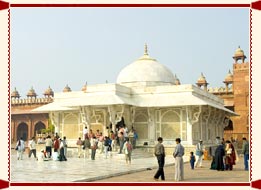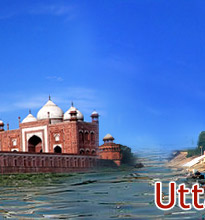 Salim
Chisti is synonymous with Sikri. Khwaza Salim Chisti was a Sufi saint of
the Chisti order in 16th century India. The saint used to reside in the
then dusty village of Sikri. It is said that Khwaza Salim Chisti blessed
emperor Akbar with a son. The son was named Salim in reverence of the
saint, who in the course of history came to be known as Emperor Jahangir
Jahandar. Akbar later ordered the commissioning of the city of Fatehpur
Sikri that had to be built out of the twin villages of Fatehpur and
Sikri.
Salim
Chisti is synonymous with Sikri. Khwaza Salim Chisti was a Sufi saint of
the Chisti order in 16th century India. The saint used to reside in the
then dusty village of Sikri. It is said that Khwaza Salim Chisti blessed
emperor Akbar with a son. The son was named Salim in reverence of the
saint, who in the course of history came to be known as Emperor Jahangir
Jahandar. Akbar later ordered the commissioning of the city of Fatehpur
Sikri that had to be built out of the twin villages of Fatehpur and
Sikri. When Khwaza Salim Chisti died, he was buried in the same Sikri complex where he once resided. A tomb that is popularly called Mazaar in Hindustani was later commissioned that stands in the middle of the courtyard of the Jama Mosque in Sikri Fort Complex. The structure falls slightly right from the line of view when one enters from the Buland Darwaza. If you take a bird eye view of this structure, it looks like a marble Jewel-box. Actually, the tomb was built originally with Red-sandstone but was later converted in to a marble one. The exterior is separated from the sanctum with the help of Jaalis. The Naqqashi and Jaali work of this low-domed tomb has fewer parallels in India.
Inside, the structure is heavily ornamented with Pearls, Lapis Lazuli and Topaz. A green cloth covers the tombstone, typical of the Sufi order. The tombstone rests under a canopy beautifully carved out of ebony and decorated with pearl and brass. A corridor for circumambulation surrounds the square tomb chamber. The place sees hordes of visitors every day and is popular as a wish-fulfilling site among the barren women.









